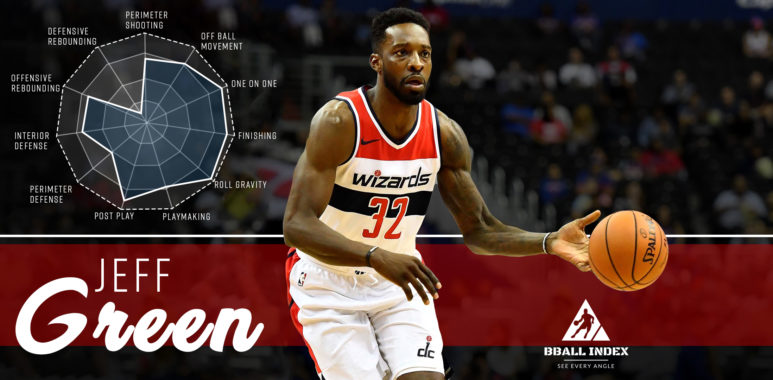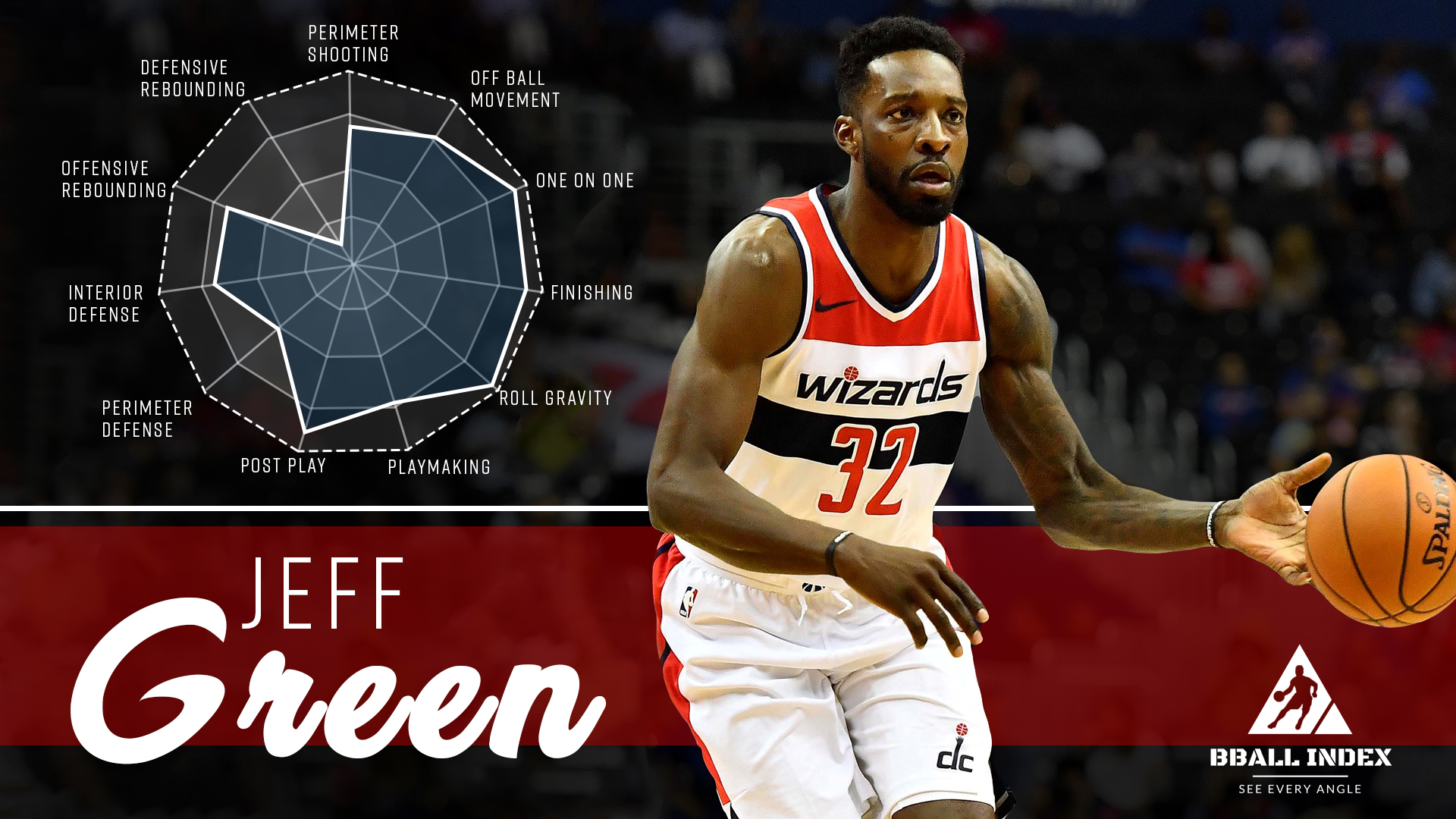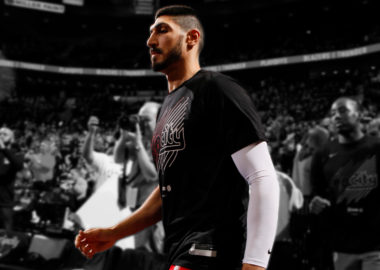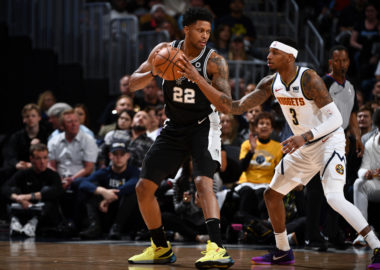
Yes, Jeff Green (and a couple bonus guys). First things first: If you’re thinking “these players are bad,” that’s kind of the point. I’m not here to tell you Nikola Vucevic is really good (he is) and act like a hipster, or tell you the Lakers should sign Jimmy Butler (they should). None of these guys are bad, but each should be somewhat under the radar.
The idea here is to identify diamonds in the rough: the role player type guys who will bring positive return on investment for their team next season and have the potential to break out with a good opportunity in a good role.
In the most basic sense, teams need players overachieving what they pay them to truly succeed, since payroll should be about the same. The stars and starters are bigger parts of that, but winning at the margins with bench guys impacting your team like starters are what can put you over the top.
And the last piece of this is that they need to be available this offseason, which disqualifies a lot of under the radar guys I think will break out or are good values that’d normally fall under this category (I’m a big fan of Jerami Grant, Domantas Sabonis, and Taurean Prince for a lot of these same reasons). And for them to be projected to be available, we’re likely looking at older guys or low draft capital players who aren’t a great fit or aren’t important for their current teams.
Past Picks
To set the stage, here are the picks I’ve made publicly over the past three seasons.
For the 2017-18 season: Ian Clark
This pick came during the end of the 2016-17 season and into the following offseason. It was a simpler time. We didn’t have player grades, PIPM didn’t exist, and I was relying on more basic stats and Synergy data rather than impact data.
The pitch for Clark was like these others: he’d be cheap, looked like a positive player, and had lots of upside if he performed anything like what he did the 2016-17 for whoever signed him next.
Unfortunately, the following season for the Pels yielded talent grades (which we can see now but couldn’t see then) that were worse than either of the previous two seasons in: Perimeter Shooting, Off-Ball Movement, Finishing, Playmaking, and Perimeter Defense.

For the 2017-18 season: Trey Burke
Burke was also a pre-grades pick. The idea for Trey Burke was that he could shoot, be a great playmaker, and be a wash defensively to not draw away from that effectiveness.
Burke had elite offensive role-adjusted points over expectation data in the G-League, had exhibited clear playmaking and shooting skills in his limited time in the NBA, and showed clear improvement year over year.
When he did play, he was excellent offensively for the Knicks. Burke got to the point where he was winning games for New York.

Burke’s defense brought his impact down a fair degree, but he was still a positive guy that the Knicks leaned on at different times that usually produced well whenever he got consistent minutes. I count this one as a win.
And actually, I’d be interested in Burke this offseason as an UFA as well. Shooting, One on One, Finishing, Playmaking, and defense is a good combo to have on a minimum deal.
For the 2018-19 season: Michael Beasley
Beas marks the change from pre-grades to having offensive and defensive talent grades. Beasley was the rare instance of the Lakers actually signing whom I wanted them to sign.
He was incredibly cheap, had an aura surrounding his legacy of disappointing on draft capital and several aloof moments clouding what has been a very talented player who gave the Knicks legitimate production for several seasons.
For LA, Beasley’s year was negatively impacted by the ill health and passing of his mother, which took him away from the team, practices, and games for much of the early season. When he did come back, he clearly flashed his One on One, Finishing, Roll Gravity, and Playmaking abilities. His shot wasn’t there and his post game was below his usual elite self in those <300 minutes he actually got, but I would have assumed we’d see positive mean reversion over time if he was given a legitimate opportunity.

For the 2018-19 season: Shabazz Napier
My other pick for this season was Shabazz Napier. I identified him not as a high upside player like Beasley, but as one who should easily bring a good ROI on the tiny deal he’d likely get (and did get at a 2 year, $3.8M total deal with a 2nd year team option).
What I expected from Napier wasn’t high talent all around, but talent in the perfect mix of areas: Perimeter Shooting, Playmaking, and Perimeter Defense. The perfect three-and-D point guard that could create on-ball for others and make smart passes, that could also easily play off-ball offensively on a LeBron James driven team.

Napier took a step back Perimeter Shooting and with his Perimeter Defense this year, but upgraded enough as an Interior Defender and One on One player to still bring that same approximate value as projected and was average or better in 7/11 talent categories.
Napier wasn’t a big hit on potential, but returned a positive ROI on his deal, will be a bargain next season if the Nets keep him around with the team option they have, and is another win I’d claim in this series of picks.
Overall, I’d say that Burke, Beasley, and Napier were all good picks. Clark didn’t hit the way I had hoped, but was still a decent offensive player and nobody outside of me and people following me would tell you he was a disaster, illustrating the low-risk nature of these picks.
Now, with all of that said, it’s time for this year’s pick (and I may add more over the next couple months as I do more research).
Next up: Jeff Green

Green will be 33 at the start of next season and is coming off of minimum contracts each of the last two seasons, so I think we can solidly project him to not be expensive. And with LA looking to add big pieces this offseason and compete, getting a vet on a tiny deal that’s played with LeBron before
Here are Green’s BBall Index talent grades since the 2013-14 season:

Green has also been a very good playmaker this past season, has been a solid rim protector four of those six years, and isn’t a sieve on the perimeter. There’s not a ton to dislike.
Green also commanded the second highest volume of possessions for the Wizards this season, so it’s not like he’s being efficient on low volume. Again, earning that stature for them (and being very efficient while doing so) while being a minimum money guy. And while his defensive impact data is poor, his grades show value and he boasts the 23rd best versatility rating defensively (something we don’t have up on the site yet publicly).
Jeff Green is clearly very talented from watching his film and seeing his performance in these grades. What I didn’t know, however, is that he’s one of only 3 players in the entire NBA this season with at least B grades in all eight offensive talent categories. He’s also part of a small group that has “career” grades (since 2013-14) of at least C grades in all 11 overall categories, which is quite a feat.
We’re not looking at one flukey year, atrocious defense, or major off-court issues that could derail Green. So what has his value being where it is? For years he was good, but overpaid. That shapes perceptions. And having poor shooting years on a big stage in Cleveland and a worse year on a smaller stage in Orlando doesn’t exactly breed trust.
Possible Outcomes
The upside to Green is a minimum level guy bringing you starter talent on top of bench minutes and being a versatile inside or outside player, on-ball with his one on one and post skills or off-ball with his spot up shooting, cutting, and rolling. Maybe he’s finishing possessions, but can just as easily be a good using his smart passing to help teammates out.
The downside to Green would be that his shooting is more like 2016-17 or 2017-17 and not like the other four seasons we have to look at, his interior defense drops to its D+ form rather than the B form we’ve seen for four of the past six years, and his playmaking is a fluke this season. That’d give us a 6’9” post guy with some rolling ability who can play one on one (A level grade all six seasons) and finish around the rim, which is less attractive. But if you get that for the minimum, who can really complain? What other lottery tickets can LA go after with minimum money who have demonstrated a substantiated high talent level?
Situation
Also for consideration is that Green has been playing under staffs with bottom fifth offensive optimization data for two of the past three seasons, making the realization of these grades into effective production dampened somewhat. But it’s there and ready to come out. Sans Luke Walton and company, LA also no longer has the league’s worst coaching staff when it comes to offensive optimization. They can only go up from there, and hopefully can secure a staff that is above average and not bottom of the barrel for the first time in a long time. If that were to be the case, as the data would say it’d be under either Monty Williams or Ty Lue, we may see Green in his full glory.
Get it Done, Lakers
To recap: Green will be cheap, he’s very talented, and should easily be a bargain for whichever team signs him. He has fantastic upside and a history and skill set (and hopefully a good environment) that hints at a “breakout” next year. At the worst, Green is an end of bench money guy bringing value on a minimum deal with several legitimate skill sets.
I’ll continue searching for other Green type players, but I want to lock Green in as “the next Ian Clark,” take number 5. Let’s go get it done, Lakers.
In the meantime, I have a couple other picks to share. I’ll note that while dozens were guessing who this piece would be out after I teased it, none of the following players were part of the article. But after digging further, I found a couple diamonds in the rough among all of the suggestions I want to include.
Secondary Pick: Dewayne Dedmon
A late add, but one I’d feel good about bringing value, would be Dewayne Dedmon. What has me hesitant to list him is what kind of deal he’ll end up getting, as he’s coming off of a 2-year $14M total deal. But he is entering his age 30 season, so there’s a good chance he ends up being a room exception, bi-annual exception, or less player. Think in the $3-$5M range. If that is the case, we’ll count him on this list. If he gets more, that’s probably too high caliber to count with these guys. Sounds good? Cool.
Dedmon is a spot up catch and shoot scorer, can pick and pop exceptionally well, and can also roll effectively. Compared to other bigs with 1,500 or more minutes, he’s a very effective perimeter defender and is above average as an interior defender as well.


Again, you’d be looking to get him for the room exception, bi-annual exception, or less. He’s clearly talented, looks to be an adequate defender that can space the floor and aid as a screener and roller/popper, and can also rebound well. I’ll happily take that off the bench as a backup center on a good team. Coming from Atlanta he may be a bit under the radar, so I have hopes he’ll be attainable.
Bonus Guys
While we’re here, let’s talk about a couple other options I’m less enthused about but would be interested in as well: Ed Davis and Wayne Ellington. Neither are guys that are anywhere near complete players, but both have specific skill sets that let you keep them on the court and can be valuable.
Davis, as an elite rebounder and very strong finisher and rim protector that can also score rolling and in the post. He’s in no way a shooter and has none of the One on One or Playmaking ability to be any sort of primary creator, but he can be your garbage man and give opposing bigs trouble.

Ellington is a known commodity as a shooter. He also has a good enough Perimeter Defense rating (and has a C+ “career” Perimeter Defense rating since 2013-14) that you can keep him on the court purely as a floor spacer and someone who can score off of shooter off-screen actions like quick pin downs or flare screens.
Both players are end of bench guys and would have very specific roles, but for minimum deals I’d take either for the end of my bench.
If I had to tier these picks, I’d go with these general groupings:
Easy value on minimum deal, starter type performance upside: Beasley, Green
Easy value on minimum deal, 6th-7th man type upside: Clark, Burke
Good value on minimum deal, no real upside: Napier, Davis, Ellington


